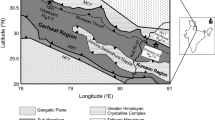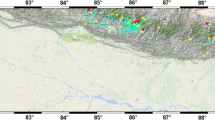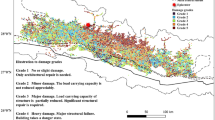Abstract
The Kutch region of Gujarat in India is the locale of one of the most devastating earthquake of magnitude (M w) 7.7, which occurred on January 26, 2001. Though, the region is considered as seismically active region, very few strong motion records are available in this region. First part of this paper uses available data of strong motion earthquakes recorded in this region between 2006 and 2008 years to prepare attenuation relation. The developed attenuation relation is further used to prepare synthetic strong motion records of large magnitude earthquakes using semiempirical simulation technique. Semiempirical simulation technique uses attenuation relation to simulate strong ground motion records of any target earthquake. The database of peak ground acceleration obtained from simulated records is used together with database of peak ground acceleration obtained from observed record to develop following hybrid attenuation model of wide applicability in the Kutch region:
In the above equation, PGA is maximum horizontal ground acceleration in gal, M w is moment magnitude of earthquake, R is hypocentral distance, and E is epicentral distance in km. The standard deviation of residual of error in this relation is 0.5. This relation is compared with other available relations in this region, and it is seen that developed relation gives minimum root mean square error in comparison with observed and calculated peak ground acceleration from same data set. The applicability of developed relation is further checked by testing it with the observed peak ground acceleration from earthquakes of magnitude (M w), 3.6, 4.0, 4.4, and 7.7, respectively, which are not included in the database used for regression analysis. The comparison demonstrates the efficacy of developed hybrid attenuation model for calculating peak ground acceleration values in the Kutch region.













Similar content being viewed by others
References
Abramson NA, Litehiser JJ (1989) Attenuation of vertical peak acceleration. Bull Seismol Soc Am 79:549–580
Biswas SK (2005) A review of structure and tectonics of Kutch basin, western India, with special reference to earthquakes. Curr Sci 88:10–25
Boore DM (1983) Stochastic simulation of high frequency ground motions based on seismological models of the radiated spectra. Bull Seismol Soc Am 73:1865–1894
Boore DM, Atkinson GM (1987) Stochastic prediction of ground motion and spectral response parameters at hard-rock sites in eastern North America. Bull Seismol Soc Am 77:440–467
Boore DM, Bommer JJ (2005) Processing of strong motion accelerograms: needs, options and consequences. Soil Dyn Earthq Eng 25:93–115
Boore DM, Joyner WB (1982) The empirical prediction of ground motion. Bull Seismol Soc Am 72(6):S43–S60
Campbell KW (1985) Strong motion attenuation relations: a ten year perspective. Earthq Spectra 1:759–804
Cramer CH, Kumar A (2003) 2001 Bhuj, India, earthquake engineering seismoscope recordings and eastern North America ground-motion attenuation relations. Bull Seismol Soc Am 93(3):1390–1394
Dimri VP (1992) Deconvolution and inverse theory: application to geophysical problems. Elsevier, Amsterdam, p 230
Douglas J (2001) A comprehensive worldwide summary of strong-motion attenuation relationships for peak ground acceleration and spectral ordinates (1969–2000). Engineering Seismology and Earthquake Engineering, London, Errata of and additions to ESEE Report No. 01-1
Fukushima Y, Tanaka T (1990) A new attenuation relation for peak horizontal acceleration of strong earthquake ground motion. Bull Seismol Soc Am 80:757–783
Hadley DM, Helmberger DV (1980) Simulation of strong ground motions. Bull Seismol Soc Am 70:610–617
Hartzall SM (1978) Earthquake aftershocks as green functions. Geophy Res Lett 5:1–4
Hartzall SM (1982) Simulation of ground accelerations for May 1980. Mammoth Lakes, California earthquakes. Bull Seismol Soc Am 72:2381–2387
Hutchings L (1985) Modeling earthquakes with empirical green’s functions (abs). Earthq Notes 56:14
Irikura K (1983) Semi empirical estimation of ground motion during large earthquake. Bull Disaster Prevvent Res Inst (Kyoto Univ) 33:63–104
Irikura K (1986) Prediction of strong acceleration motion empirical green’s function. In: Proceedings of the 7th Japan earthquake engineering symposium, pp 151–156
Irikura K, Muramatu I (1982) Synthesis of strong ground motion from large earthquake using observed seismograms of small event. In: Proceeding of 3rd international earthquake microzonation conference, Seattle, pp 447–458
Iyengar RN, Raghukanth STG (2004) Attenuation of strong ground motion in peninsular India. Seismol Res Lett 79(5):530–540
Joshi A (1997) Modeling of peak ground acceleration for Uttarkashi earthquake of 20th October, 1991. Bull Indian Soc Earthq Tech 34:75–96
Joshi A (1998) Study of the Uttarkashi earthquake in terms of rupture model and isoseismals. J Geophys 19:133–140
Joshi A (2000) Modelling of rupture planes for peak ground accelerations and its application to the isoseimal map of MMI scale in Indian region. J Seismol 4:143–160
Joshi A, Midorikawa S (2004) A simplified method for simulation of strong ground motion using finite rupture model of the earthquake source. J Seismol 8:467–484
Joshi A, Mohan K (2008) Simulation of accelerograms from simplified deterministic approach for the 23rd October 2004 Niigata-ken Chuetsu, Japan earthquake. J Seismol 12:35–51
Joshi A, Patel RC (1997) Modeling of active lineaments for predicting possible earthquake scenario around Dehradun, Garhwal Himalaya, India. Tectonophysics 283:289–310
Joshi A, Singh S, Giroti K (2001) The simulation of ground motions using envelope summations. Pure Appl Geophys 158:877–901
Joshi A, Kumar B, Sinvhal A, Sinvhal H (1999) Generation of synthetic accelerograms by modelling of rupture plane. ISET J Earthq Technol 36(1):43–60
Joshi A, Mohanty M, Bansal AR, Dimri VP, Chadha RK (2010) Use of spectral acceleration data for determination of three-dimensional attenuation structure in the Pithoragarh region of Kumaon Himalaya. J Seismol 14:247–272
Joshi A, Kumari P, Singh S, Sharma ML (2012a) Near field and far field simulation of accelerograms of Sikkim earthquake of September 18, 2011 using modified semi empirical approach. Nat Hazards 64:1029–1054
Joshi A, Kumari P, Kumar S, Sharma ML, Ghosh AK, Agarwal MK, Ravikiran A (2012b) Estimation of model parameter of Sumatra earthquake using empirical green’s function technique and generation of hypothetical earthquake scenario for Andaman Island, India. Nat Hazards 62:1081–1108
Joyner WB, Boore DM (1988) Measurement, characterization and prediction of strong ground motion. In: Proceeding of earthquake engineering and soil dynamics II, Utah, pp 43–100
Kamae K, Irikura K (1998) Source model of the 1995 Hyogoken Nanbu earthquake and simulation of near source ground motion. Bull Seismol Soc Am 88:400–412
Kameda H, Sugito M (1978) Prediction of strong earthquake motion by evolutionary process model. In: Proceeding of 6th Japan earthquake engineering symposium, pp 41–48
Kanamori H (1977) The energy release in great earthquakes. J Geophys Res 82:2981–2987
Kanamori H (1979) A semi empirical approach to prediction of long period ground motions from great earthquake. Bull Seismol Soc Am 69:1645–1670
Kanamori H, Anderson DL (1975) Theoretical basis of come empirical relations in seismology. Bull Seismol Soc Am 65:1073–1095
Kumar D, Teotia SS, Khattri KN (1997) The representation of attenuation characteristics of strong motions observed in the 1986 Dharamsala and 1991 Uttarkashi earthquakes by available empirical relations. Curr Sci 73:543–548
Lai SP (1982) Statistical characterization of strong motions using power spectral density function. Bull Seismol Soc Am 72:259–274
Levenberg K (1944) A method for the solution of certain non-linear problems in least squares. Q Appl Math 2:164–168
Mandal P, Rastogi BK, Satyanarayana HVS, Kousalya M (2004) Results from local earthquake velocity tomography: implications toward the source process involved in generating the 2001 Bhuj earthquake in the lower crust beneath Kachchh (India). Bull Seismol Soc Am 94(2):633–649
Mandal P, Kumar N, Satyamurthy C, Raju IP (2009) Ground-motion attenuation relation from strong-motion records of the 2001 Mw 7.7 Bhuj earthquake sequence (2001–2006), Gujarat, India. Pure Appl Geophys 166:1–19
Midorikawa S (1993) Semi empirical estimation of peak ground acceleration from large earthquake. Tectonophysics 218:287–295
Mikumo T, Irikura K, Imagawa K (1981) Near field strong motion synthesis from foreshock and aftershock records and rupture process of the main shock fault (abs). IASPEI 21st General Assembly, London
Munguia L, Brune JM (1984) Simulation of strong ground motion for earthquakes in the Mexicali-Imperial valley. In: Proceedings of workshop on strong motion simulation and earthquake engineering applications Pub. 85-02. Earthquake Engineering Research Institute Los Altos California 21-19
Petersen MD, Rastogi BK, Schweig ES, Harmsen SC, Gomberg JS (2004) Sensitivity analysis of seismic hazard for the northwestern portion of the state Gujarat, India. Tectonophysics 390:105–115
Rajendran CP, Rajendran K (2001) Character of deformation and past seismicity associated with the 1819 Kachchh earthquake, northwestern India. Bull Seismol Soc Am 91(3):407–426
Rastogi BK (2004) Damage due to the Mw 7.7 Kutch, India earthquake of 2001. Tectonophysics 390:1–4
Saikia CK (1993) Ground motion studies in great Los Angles due to Mw = 7.0 earthquake on the Elysian Thrust fault. Bull Seismol Soc Am 83:780–810
Saikia CK, Herrmann RB (1985) Application of waveform modeling to determine focal mechanisms of four 1982 Miramichi aftershocks. Bull Seismol Soc Am 75:1021–1040
Shakal AF, Huang MJ, Graizer VM (2004) CSMIP strong motion data processing. In: Proceedings of the international workshop on strong motion record processing May 26–27, COSMOS, Richmond, CA
Singh SK, Pimprikar SD, Bansal BK, Pacheco JF, Dattatrayam RS, Suresh G (2007) An analysis of the Mw 4.7 Jabalpur, India, earthquake of 16 October 2000: toward ground-motion estimation in the region from future events. Bull Seismol Soc Am 97:1475–1485
Wells DL, Coppersmith KJ (1994) New empirical relationships among magnitude, rupture length, rupture width, and surface displacements. Bull Seismol Soc Am 84:974–1002
Yu G (1994) Some aspect of earthquake seismology: Slip partitioning along major convergent plane boundaries; Composite source model for estimation of strong motion; and nonlinear soil response modeling. Ph.D. Thesis, University of Nevada, Reno
Yu G, Khattri KN, Anderson JG, Brune JN, Zeng Y (1995) Strong ground motion from the Uttarkashi earthquake, Himalaya, India, earthquake: comparison of observations with synthetics using the Composite source model. Bull Seismol Soc Am 85:31–59
Zeng Y, Anderson JG, Su F (1994) A composite source model for computing realistic synthetic strong ground motions. Geophys Res Lett 21:725–728
Acknowledgments
Authors sincerely thank Department of Science and Technology Gujarat, for carrying the research work presented in this paper. Thanks are also due to the Indian Institute of Technology Roorkee, India and Institute of Seismological Research, Ghandhinagar, Gujrat, India for supporting this research work.
Author information
Authors and Affiliations
Corresponding author
Rights and permissions
About this article
Cite this article
Joshi, A., Kumar, A., Mohan, K. et al. Hybrid attenuation model for estimation of peak ground accelerations in the Kutch region, India. Nat Hazards 68, 249–269 (2013). https://doi.org/10.1007/s11069-012-0524-7
Received:
Accepted:
Published:
Issue Date:
DOI: https://doi.org/10.1007/s11069-012-0524-7




